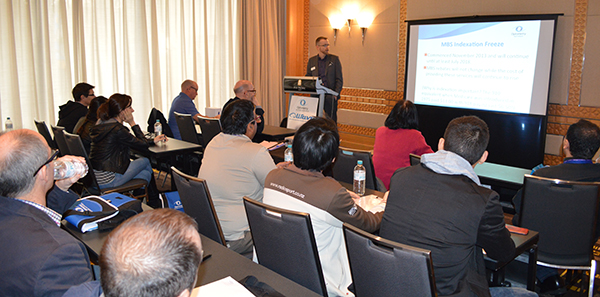1:30min

Luke Arundel delivers his advice on Medicare, WAVE 2015
______________________________
By Rhiannon Riches
Assistant Editor
Knowing the full scope of Medicare items can present opportunities to maximise patients’ rebates.
Luke Arundel, national professional services manager, fields many calls from Optometry Australia members seeking counsel on Medicare-related matters.
‘A common source of confusion for optometrists is items 10912 and 10913. The current rules state that these items can be applied only to an existing patient at the practice but some members are using these items for patients new to a practice,’ Mr Arundel said.
Following advocacy from Optometry Australia, the wheels are in motion for these items to include new patients but it will take some months to be written into law and become officially sanctioned.
Maximise Medicare
Optometry Australia analyses Medicare data to understand how optometrists are utilising or under-utilising the full scope of items for the most appropriate billing and fiscal benefit.
Mr Arundel said that some members were unaware that they could review their own utilisation of Medicare items and compare their data against peers across Australia. He said that many years ago this data was routinely sent to all optometrists and that it was still available on the Medicare website.
‘We want our members to bill smarter, not work harder,’ national clinical policy advisor Simon Hanna said.
In September 2015, item 10944 was introduced for optometrists removing corneal foreign bodies. It took nearly 10 years to get the item on the Medicare Benefits Schedule (MBS).
‘We know that only 20 per cent of registered practitioners used item 10944 in 2015,’ Mr Hanna said.
Four new telehealth items were also introduced in September 2015, but only 15 practitioners used any of the four items, and those who did were mostly in Western Australia.
‘Private fees can be charged for these services as they can for any other Medicare item,’ Mr Hanna said.
When identifying reasons to explain the limited use of the telehealth items, Mr Hanna cited confusion over the terms of use.
‘Patient eligibility is important when billing any of the four telehealth items,’ he said. ‘Adequate clinical record-keeping, including the nature and location of the embedded corneal foreign body and method of removal, is also paramount when using item 10944.’
Mr Hanna said that the children’s vision assessment item 10943 was another very under-utilised item in the MBS. This is an item for additional testing to confirm diagnosis of or to establish a treatment regime for a significant binocular or accommodative dysfunction.
He said that due to the unfamiliarity with this item, many optometrists were actually meeting the requirements of this add-on item but were not billing for it.
Triple strain
On 1 January 2015, the Australian Government introduced a five per cent reduction in optometry MBS fees, an indexation freeze to July 2018 and a change in frequency of comprehensive eye examinations.
These three changes to the MBS have resulted in a seven per cent drop in optometry Medicare benefits paid between 2014 and 2015, equating to a reduction of nearly $28 million.
‘The health-care system is under massive strain. The squeeze is on,’ Mr Arundel said.
In the current MBS review, out of a total of 3,700 items, optometry had two items in the 40 most common MBS items that accounted for about 70 per cent of all services. Those two items were 10900 and 10918.
The next MBS review report is due in December 2016 and Optometry Australia has represented the profession at all stages of the review process so far.
‘The first step in maximising optometric benefits for patients under Medicare is to help Optometry Australia ensure optometry’s place in the Medicare system and help claw back some of the negative changes,’ Mr Arundel said.
With optometrists’ support, Optometry Australia delivered more than 18,000 signatures to parliament in October 2015 in a petition to reverse the changes introduced on 1 January 2015.
‘The next step is to keep campaigning in 2016, an election year. Our policy team has finalised templates to enable optometrists to write to their local Member of Parliament.
‘Our advocacy target is three-fold: to change the time interval on initial consultation for 40- to 65-year-olds, to introduce a bulk-billing incentive plan for concession card holders and children under 16, and to undo the freeze on indexation,’ Mr Arundel said.
Mr Hanna and Mr Arundel spoke at SRC in March about how to make best use of the MBS. Their presentation is available on the Optometry Australia website.
The latest MBS schedule, an item use guide with expanded descriptions on utilising the MBS and other Medicare resources are also located on the website.
Questions on use of the MBS, analysing provider data or item interpretation can be directed to l.arundel@optometry.org.au or 03 9668 8560.